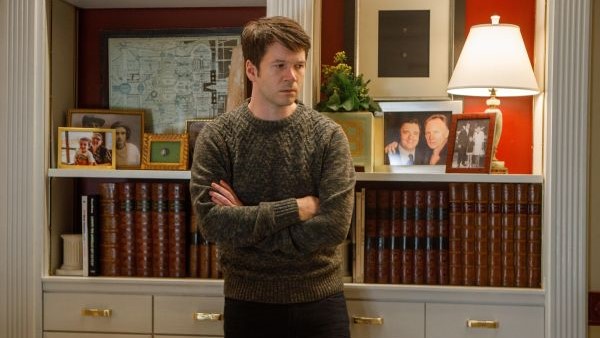'Only Murders in the Building' and the history of TV’s no dialogue episodes
The Hulu series joins 'The Twilight Zone,' 'Buffy' and 'Evil' in this bold narrative choice.

This post contains spoilers for Only Murders in the Building.
One of television’s strengths is its ability to take the expected format and turn it on its head, be it a bottle episode or a pre-recorded series trying its hand at a live performance. Often, a few seasons pass before a show dips its toes into the experimental narrative shifting waters, but Hulu’s Only Murders in the Building is not playing it safe during its first season. “The Boy From 6B” joins an elite roster of shows that broke with dialogue conventions, and this is far more than an audacious gimmick.
A few scenes might unfold before you even register exactly what is different as the seventh episode of Only Murders in the Building ditches the true crime podcast-style narration in favor of subtitles and American Sign Language. Teddy Dimas (Nathan Lane) is now the prime suspect in the murder being investigated by the Arconia residents Mabel (Selena Gomez), Oliver (Martin Short) and Charles (Steve Martin), but little do they know that they too are being watched by Teddy’s deaf son, Theo (James Caverly). The opening flashback introduces the ambient soundscape of Theo’s point of view, which will be used throughout to indicate when the scene is shot from Theo’s perspective. Lip reading and sign language are the two dominant forms of communication, but text messages between other characters are utilized when Theo isn’t privy to the contents.
“People talk way too much in this city,” Theo signs in place of the voiceover before the opening credits hit, and what follows is a unique entry into the annals of “silent” TV. Unlike the season 2 episode of Master of None —which includes an eight-minute long sequence without music or spoken dialogue to represent a young deaf woman’s daily experience — “The Boy From 6B” does feature the evocative score to build tension. ALS is featured not only during Theo’s conversations with his father but also with Mabel’s friend Zoe (Olivia Reis), whose untimely death is another case that needs solving.
Director Cherien Dabis told Variety that “when dialogue is not a factor, then you have to really think deeply about the visual storytelling.” Dabis also consulted with Caverly regarding how to authentically evoke the way he experiences the world. It is an effective, achingly sad and haunting episode that peels back the layers of this mystery while also giving insight into who Theo is beyond a surface-level glance. Furthermore, it is an episode that demands all of your attention, and the temptation to scroll through your phone (something I am guilty of) is removed. It isn't until Charles exclaims “We did it” at the end of “The Boy From 6B” that signals a return to the regular format, even if the danger is far from over.
The limited dialogue framework can also serve a different purpose than just assimilating, but also to isolate or add a disquieting atmosphere. This is most likely to boost horror situations like in A Quiet Place, and TV has some notable examples that effectively reduce or eliminate words spoken out loud to ramp up the tension. So whether it is to reveal more about a character as Only Murders in the Building successfully achieved or creating a scenario that means alternative methods of communicating are necessary — also something the Hulu crime comedy tapped into — this is often a rewarding viewing experience and one that continues to throw up new ways to tap into the silence or inability to speak out loud.
Below are five more of the best-limited dialogue episodes.
The latest updates, reviews and unmissable series to watch and more!
'Buffy the Vampire Slayer' - “Hush” (Season 4, Episode 10)
It takes 13 minutes of screentime before the Sunnydale residents’ voices are stolen by the terrifying (and floating) Gentlemen while they slumber. Everything that precedes this is business as usual for Buffy (Sarah Michelle Gellar) and her friends as they soak up everything college has to offer. Buffy has an unnerving dream during a lecture, which begins hot and heavy before shifting into a nightmarish vibe. Conversations centering on language-based remarks litter the script from Willow (Allyson Hannigan) complaining the Wiccan group she has joined is “all talk” and Giles (Anthony Head) getting a late-night visitor who gets the “small talk” out of the way.
The following morning sparks a change that at first feels like the sound has been accidentally cut until you realize the score is still playing. It's not your TV but part of the plot of “Hush,” which remains one of the best and most beloved episodes of Buffy. In a world where supernatural entities have the ability to stop Sunnydale dead in its tracks, it is notable when Buffy can no longer offer a quip to break the mood. Although in true Scooby-Doo tradition, there are still plenty of funny moments — such as Giles's unique presentation.
'Evil' - “S is for Silence” (Season 2, Episode 7)
Paramount Plus’ gem Evil recently got in on the limited dialogue action when investigators Kristen (Katja Herbers), David (Mike Colter) and Ben (Aasif Manvi) are sent to a monastery to determine whether a deceased monk should be submitted for Sainthood. This is a spiritual location that has practiced silence for 130 years and they take this mandate very seriously. This isn’t a time to challenge the rules as the reason behind this vow of silence is to keep a demon locked within a terrifying cabinet and any utterance will supposedly set it free. When they arrive, the trio give up their phones — taking away the texting option — and are given retro Magic Slate boards in order to “talk” to each other.
One of Evil’s strengths is marrying absurd and scary stories with belief acting as the foundation. Neither Kristen nor Ben think the demon is real and yet they still adhere to this set of rules and only speak outside of the grounds in hushed tones. This brief respite from non-verbal communication gives them the chance to give more detailed updates and offers a pause for the audience too. There is also a lot of unspoken sexual tension between Kristen and David that comes to the forefront via written communication, crossed wires and a very funny subtitled look at David’s thoughts. It is unsurprising that a show as inventive as this one is also more than capable of delivering an episode as strong as “S is for Silence.”
'Mr. Robot' - “405 Method Not Allowed” (Season 4, Episode 5)
Elliot (Rami Malek) is a man of very few words, but he keeps the audience informed of his every thought via an ongoing inner monologue delivered as a voiceover. This is not the case in this tense final season outing that opens with his sister Darlene (Carly Chaikin) picking him up on this festive morning. The pair have been going through a rough patch and she tells him “It’s cool, dude, we don’t have to talk.” Elliot dutifully obliges and they don’t even need to confer about the heist they are about to commit. They might be at odds but there has always been an unspoken understanding, and later this is cemented when Darlene saves the day.
In this episode, creator Sam Esmail pays homage to the 1955 French crime thriller Rififi, which includes a half-hour dialogue-free sequence during a daring jewelry heist. The Mr. Robot creator has always pushed the envelope visually with this hacker series and in a standout final season this silent episode sings.
'The Twilight Zone' - “The Invaders” (Season 2, Episode 15)
Long before Buffy the Vampire Slayer set the benchmark for this technique, The Twilight Zone beat the supernatural series to the punch by nearly 40 years with its unnerving “The Invaders.” Airing in 1961, it follows an older woman (Agnes Moorehead, better known for playing Endora on Bewitched) who lives in a “house untouched by progress.”
Rod Serling’s familiar intro sets the scene, but what follows is a masterclass from Moorehead who performs alone — well, aside from the puppets she acts against — and lets her expressions do the talking. Yes, there are moans of terror at the auditory distress and shrieks of fear at those invading what is meant to be a safe space, but aside from the message the creatures send home, it is dialogue-free. Sixty years later, “The Invaders” is still an effective look at who the real monsters are and is available to watch on Paramount Plus.
'The X-Files' - “Rm9sbG93ZXJz” (Season 11, Episode 7)
It was surprising it took Chris Carter so long to do a silent episode, and while the revived X-Files wasn’t up to the standard of the original series, this Black Mirror-leaning outing is one of the highlights. Mulder (David Duchovny) and Scully (Gillian Anderson) are both preoccupied with their phones while they have dinner together at a sushi restaurant staffed by robots. Technology-related issues persist throughout that the two FBI agents must fend off before it turns deadly.
“We learn from you,” is the typed-out message Mulder receives after he finally relents and tips. The sentiment is a little heavy-handed but it is through Duchovny and Anderson’s performances that we can let this slide while embracing this narrative choice. The chemistry that set this ship alight in the ‘90s was still very much on fire and the hand holding shot at the end is a gesture worth a thousand words.
Emma Fraser spends most of her time writing about TV, fashion, and costume design; Dana Scully is the reason she loves a pantsuit. Words can also be found at Vulture, Elle, Primetimer, Collider, Little White Lies, Observer, and Girls on Tops. Emma has a Master’s in Film and Television, started a (defunct) blog that mainly focused on Mad Men in 2010, and has been getting paid to write about TV since 2015. It goes back way further as she got her big start making observations in her diary about My So-Called Life’s Angela Chase (and her style) at 14.


